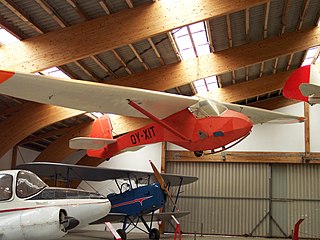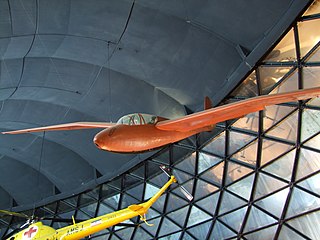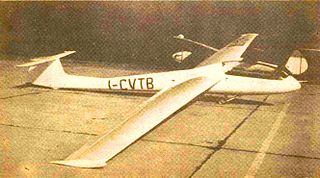
The Göppingen Gö 4 or Goevier is a German sailplane of the late 1930s used for training pilots. Its most notable features include side-by-side seating and dual controls, making the plane ideal for use as a trainer. It boasted average performance, compared to other gliders of the day, and was advertised as making the process of learning to fly sailplanes easier.
The IS-5 Kaczka was a single-seat canard research glider designed and built in Poland from 1948.

The Slingsby Type 34 Sky is a high performance single seat competition sailplane built in the United Kingdom. It was successful in major events, particularly in the World Gliding Championships of 1952.

The Slingsby Type 45 Swallow was designed as a club sailplane of reasonable performance and price. One of the most successful of Slingsby's gliders in sales terms, over 100 had been built when production was ended by a 1968 factory fire.

The Oberlerchner Mg 23 is a single-seat, all-wood, high-performance sailplane. It was built and first flown in Austria in 1955, and a total of 26 were built before production ended in 1965.

The HKS-1 was a German 19 19 m (62.3 ft) span high performance two seat sailplane, designed around 1950 to use recent advances in laminar flow airfoils. To avoid premature transition from laminar flow caused by surface interruptions, the HKS-1 dispensed with hinged ailerons, flaps and spoilers and replaced them with a flexible trailing edge. Two were built, setting several records.

The Raab Doppelraab is a German training glider produced in the early 1950s which proved popular with gliding clubs. A student pilot was accompanied by an instructor in a small space behind him, sharing the control column and with a dual rudder bar. The Doppelraab could be flown solo for later basic training.

The Arsenal Air 100 is a French single seat competition sailplane produced in the 1940s. It sold in small numbers but set several records, still holding the world absolute solo glider endurance record of 56 h 15 m.

The Breguet Br 905 Fauvette is a single-seat, standard class, competition sailplane, designed and produced in France from the late 1950s. Some 50 were built but most remained grounded after a structural accident in 1969; a few remain airworthy.

The Ikarus Košava is a two-seat sailplane designed and built in Yugoslavia in the early 1950s. It won the 1954 World Gliding Championships in the two seat category and came second in the same event two years later.

The Breguet Br 104 Nymphale is a two-seat training and competition sailplane, built in France in the 1950s. A direct development of the successful Breguet Br 901 Mouette, it competed at two World Gliding Championships but has mostly been used, in small numbers, by gliding clubs.

The Cijan-Obad Orao is a competition single seat sailplane designed in Yugoslavia just after World War II, one of the most advanced of its type at the time. It flew in three World Gliding Championships, having greatest success at its first in 1950 when it reached third place.

The Ikarus Meteor is a long-span, all-metal sailplane designed and built in Yugoslavia in the 1950s. It competed in World Gliding Championships (WGC) between 1956 and 1968 and was placed fourth in 1956; it also set new triangular-course world speed records.

The DFS Rhönsperber, otherwise known as the Schweyer Rhönsperber or Jacobs Rhönsperber was a single seat competition glider designed in Germany by Hans Jacobs and first flown in 1935. For several years it was regarded as the best German sailplane and about one hundred were built.

The CVT2 Veltro was an Italian competition glider built in the mid-1950s. Its advanced design incorporated a laminar flow wing, T-tail, retracting undercarriage and a reclining seat to reduce parasitic drag.

The Scheibe Specht is a tandem seat training glider produced in Germany in the early 1950s. More than fifty were built.
The Schneider Grunau 7 Moazagotl was a high-performance sailplane designed in Germany in 1933 specifically for fast, long distance flying using strong thermals. In 1937 it came second in the first World Gliding Championships, having previously made a flight of 300 km (186 mi).

The Oberlerchner Mg 19 Steinadler is an Erwin Musger designed two seat tandem trainer glider built in Austria and first flown in 1951. Several examples of this successful aircraft, which competed in the two seat class at two World Gliding Championships in the 1950s, were still flying in 2000.
The Bréguet Br 902 Cinzano was a French training glider produced in the 1950s by Société anonyme des Ateliers d'aviation Louis Bréguet






















